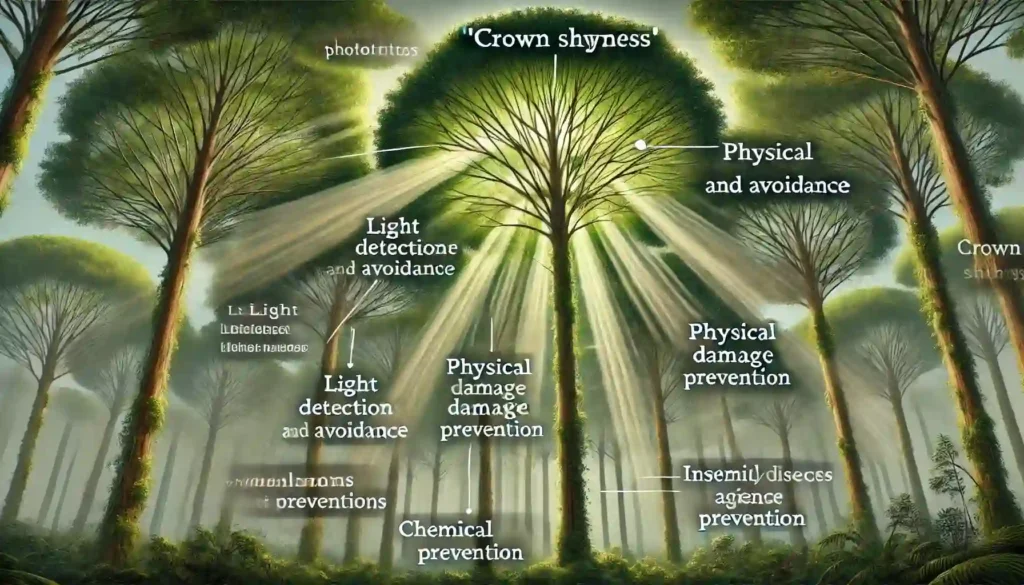Table of Contents
Crown Shyness
Crown shyness, also known as crown shy or the shyness of the crown, is an interesting natural phenomenon in some forest canopies. What is crown shyness in trees? It’s when the uppermost branches of a few tree species seem to avoid touching each other. This creates a striking pattern from ground or aerial views: gaps or channels between the crowns of neighboring trees, which much resemble a network of veins or a jigsaw puzzle. Because of this intriguing behavior, many scientists, nature enthusiasts, and photographers were drawn to study what causes crown shyness in trees.
The Discovery and Prevalence of Crown Shyness
The term “crown shyness” was first used in the 1920s by Australian forester worker Maxwell Jacobs. However, different naturalists and researchers have already observed and described the phenomenon. It’s not definitely a universal condition throughout all tree species or forests. Crown shyness tree locations are most commonly observed in:
- Some tropical and subtropical forests
- Some temperate forest ecosystems
- Specific tree species, such as eucalyptus, pine, and some deciduous trees
Read also: Anthurium Black Beauty – A Houseplant
Understanding Mechanisms Under Crown Shyness
Although there are a lot of arguments against it, the exact cause of crown shyness is still contested, and several theories have been lodged to explain these behaviors. Many researchers are still trying to answer the question: why does crown shyness occur?
1- Light Detect and Avoid
Trees require sunlight to perform photosynthesis, the only developed mechanism by which trees produce energy. There is an assumption on the part of trees that a physiologic mechanism is developed; through the light-sensitive pigment mechanism, closer branches develop. This will enable trees to independently detect the presence of their close branches, allowing them to grow in such a way that they will be capable of having maximum exposure to light without budding into each other.
2- Physical Damage and Abrasion Prevention
Another explanation takes into account the physical interaction between trees. When wind causes branches to swing and bump together, the ensuing abrasion can shred the sensitive tips of growing shoots of trees. This crown shyness may be an evolutionary adaptation that enables trees to reduce this damage by making them sensitive to contact, thus altering their growth pattern accordingly.

3- Chemical Signaling
Several other researchers maintain that even yet trees emit certain signals of chemicals in the air for them to communicate with the kinship. Being chemically rich, these signals hereby support information among the surrounding trees of certain species concerning self-identification and location, which also allows them to match patterns of growth consequently causing crown shyness.
4- Insect and Disease Prevention
The gaps caused by crown shyness might give some deterrent to the passage of undesirable insects and many diseases passing from one tree to the other. If trees have not closed full—meaning retained some spacing—the potential that the affected areas would not be as great as in their neighbors.
The Ecological Importance of Crown Shyness
Besides being visually dynamic and appealing, crown shyness serves several important roles in forest ecosystems. But what does crown shyness do for the environment?
Increased biodiversity: In this situation, gaps between tree canopies allow more light to reach the forest floor and promote high species diversity of the understorey plants and animals.
Improved health of the forest: Crown shyness, about other trees and plants, may add up to the resilience of the whole forest biome by preempting competition for resources, thus reducing instances of physical damage.
Improved nutrient cycling: Crown shyness openings can allow water and nutrients to move through the forest canopy.
Exploring crown shyness in nature. For those interested in witnessing this remarkable phenomenon firsthand, here are some tips:
- Look for forests with known crown shyness-exhibiting species.
- Best visited on clear, sunny days when sunlight can reach through the canopy gaps.
- Bring binoculars or a camera with a zoom lens to get a better view.
- Participate in guided nature walks or forest ecology tours.

You might even find crown shyness video footage online to get a better understanding of how this phenomenon looks in real time.
The Future of Crown Shyness Study
The more we learn about forest ecosystems, the more we will learn about crown shyness. Active research in this area involves:
- High-throughput methodologies of advanced imaging to map and characterize crown shyness patterns.
- Genetic studies to identify potential hereditary factors.
- Long-term monitoring for possible climate-driven changes in crown shyness.
- Investigation into the dynamics of crown shyness and what trees feature crown shyness.
So, leaving crown shyness aside, it has to remain one of the most gripping enigmas in nature. Although the phenomenon of crown shyness is completely fascinating by itself, it gives so much insight into the very elaborate interactions between trees and their surroundings. Until scientists unravel the how and why, the phenomenon remains amazing for its intricate balance and intelligence, a hallmark of forest ecosystems.
Is crown shyness a real thing?
Many people ask this question, and yes, it is real. Crown shyness in trees has been indirectly observed and studied by scientists for a very long time; however, not all tree species have this phenomenon, and its intensity may differ between species and environments.
The term “crown shy,” though, may at times connote different meanings. In this regard, people might sometimes mistake it for the rather famous Michelin-starred restaurant called “Crown Shy” in New York City. On that note, we consider the question “Is Crown Shy Michelin star?” with respect to the restaurant—not the tree phenomenon.
Crown shyness meaning, or, crowned shy meaning, all the same in botanical terminology, would be the phenomenon involving certain species of trees that would instinctively make space between their canopies. There are some very amazing ways that trees learn to live together; this is one way with the shy crown behavior when planning a forest ecosystem.
Also read: A Unique Artist Who Turns Leaves Into Art
This crown shyness habit will compel the botanist, ecologist, and even nature fancier to “look up” and appreciate the truly wonderful things our world’s forests have been hiding in plain sight all along. But the closer we look into the reasons for this happening, the more intricate our natural world becomes.



